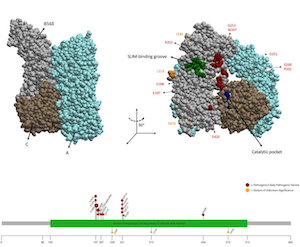Abstract
Background Variants in PPP2R5D, affecting the regulatory B56δ subunit of protein phosphatase 2A (PP2A), have been identified in individuals with neurodevelopmental abnormalities. However, the molecular and clinical spectra remain incompletely understood.
Methods Individuals with PPP2R5D variants were enrolled through Simons Variation in Individuals Project/Simons Searchlight. Data were collected from medical history interviews, medical record review, online validated instruments and neuroimaging review. Genetic variants were biochemically characterised.
Results We studied 76 individuals with PPP2R5D variants, including 68 with pathogenic de novo variants, four with a variant of uncertain significance (VUS) and four siblings with a novel dominantly inherited pathogenic variant. Among 13 pathogenic variants, eight were novel and two (p.Glu198Lys and p.Glu200Lys) were highly recurrent. Functional analysis revealed impaired PP2A A/C-subunit binding, decreased short linear interaction motif-dependent substrate binding or both—with the most severe phenotypes associated with variants that completely retained one of these binding characteristics and lost the other—further supporting a dominant-negative disease mechanism. p.Glu198Lys showed the highest C-binding defect and a more severe clinical phenotype. The inherited p.Glu197Gly variant had a mild substrate binding defect, and three of four VUS had no biochemical impact. Common clinical phenotypes were language, intellectual or learning disabilities (80.6%), hypotonia (75.0%), macrocephaly (66.7%), seizures (45.8%) and autism spectrum disorder (26.4%). The mean composite Vineland score was 59.8, and most participants were in the ‘moderate to low’ and ‘low’ adaptive levels in all domains.
Conclusion Our study delineates the most common features of PPP2R5D-related neurodevelopmental disorders, expands the clinical and molecular spectrum and identifies genotype–phenotype correlations.
